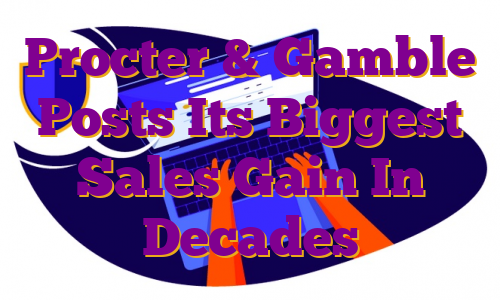Procter & Gamble Co. posted its biggest quarterly sales gain in at least two decades as consumers, undeterred by inflation and the threat of a recession, paid more for household mainstays including Pampers diapers and Gillette razors.
The Cincinnati consumer-products company said organic sales rose 10% for the quarter ended March 31, the biggest jump since P&G started tracking the metric 20 years ago. Organic sales is a closely watched figure that strips out deals and currency moves.
P&G’s priciest offerings were in highest demand, the company said, continuing a trend that has persisted throughout the pandemic. Rather than switching to discount alternatives, consumers on average switched to even-pricier products, from fragrance-free diapers to high-end razors, P&G finance chief Andre Schulten said in an interview.
“So far, the consumer is holding up and they clearly see the value in the superiority of our brands,” he said.
The strongest growth was in P&G’s healthcare segment, which houses brands such as Crest toothpaste and Vicks cold medicine. Organic sales in that unit rose 16% as the company raised prices, consumers switched to premium products and a more severe cough, cold and flu season drove up demand for over-the-counter medications. The two divisions that make home-care and laundry products and baby and feminine-care products each notched 10% gains.
Pricing overall rose 5%, while sales volumes increased 3%. The only drag was foreign exchange, which lowered revenue by 3%.
Profit increased as well, albeit more modestly than sales, as P&G absorbed higher costs for materials and transportation and spent more on new products and packaging. P&G reported earnings per share of $1.33, up 6% from the same period a year earlier, while revenue climbed 7% to $19.4 billion.
Analysts polled by FactSet predicted earnings per share of $1.29 and sales of $18.7 billion. P&G reported net income of $3.4 billion; analysts predicted $3.3 billion for the quarter.
U.S. inflation hit a four-decade high of 8.5% in March compared with the same month a year earlier, driven by skyrocketing energy and food costs, supply constraints and strong consumer demand. Many of the world’s companies are bracing for belt-tightening by consumers, and analysts and industry executives are seeing early signs of a spending slowdown.
But spending on household staples remains strong. The biggest U.S. supermarket operators are reporting rising sales and profits as they raise prices of many products rather than absorb all increases.
Should a recession hit and consumers begin to balk at higher prices, P&G would face its first test of operating in an economic downturn since the company’s sales growth dropped to anemic levels in 2009 amid the financial crisis and didn’t recover for a decade.
Mr. Schulten said the company is better prepared.
It unloaded businesses, such as its beauty unit, that tend to dip in tough financial times. The company has invested in lower-price alternatives to its costliest brands, expanded into dollar and club stores that draw deal seekers and has begun to focus marketing on the savings potential in more-expensive products.
For instance, P&G for years has offered laundry detergent that can be effective in cold-wash cycles. Recently it has begun to promote the product more heavily, making the case that savings from using cold water outweigh the added expense of the detergent.
“We’re watching carefully and we believe we’re better positioned than we ever were,” for a slowdown in consumer spending, Mr. Schulten said.
P&G on Wednesday raised its organic-sales growth forecast to a range of 6% to 7%, up from its earlier forecast of 4%-to-5% growth for the fiscal year ending June 30. It predicted core earnings per share will rise about 3%, the low end of its forecast of 3%-to-6% growth.
This story has been published from a wire agency feed without modifications to the text
Subscribe to Mint Newsletters * Enter a valid email * Thank you for subscribing to our newsletter.
.

